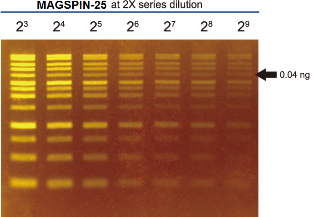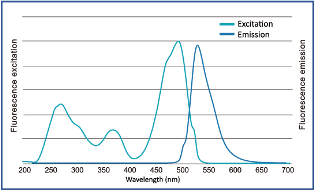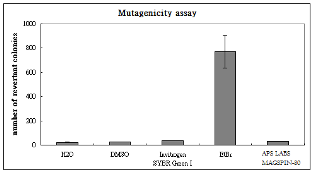
MAGFluoroStain DNA Fluoresent Staining Dye
The MAGFluoroStain™ DNA Fluorescent Staining Dye is designed to be a safer replacement for conventional Ethidium bromide (EtBr) which poses a significant health and safety hazard for its users. The MAGFluoroStain™ DNA Fluorescent Staining Dye offers at least 10 times sensitivity in DNA detection levels, and is capable of detecting double stranded DNA (dsDNA) fragments up to 0.04 ng in electrophoresis analysis (Fig. 1). The MAGFluoroStain™ DNA Fluorescent Staining Dye shows a high specificity to the dsDNA, with negligible background signal, making the destaining process entirely optional. MAGFluoroStain™ DNA Fluorescent Staining Dye is compatible with both the conventional ultra violet gel-illuminating systems as well as the less harmful long wave length blue light illumination systems. The emission when bound to dsDNA is 522 nm, while its excitation peaks are at 270, 370 and 497 nm (Fig. 2).
- Features
Excellent for post staining
Sensitivity: 0.04 ng DNA
A safe alternative to EtBr
Compatibility: suitable for blue or UV light
Increased cloning efficiency (blue light)

Fig.1. MAGFluoroStain DNA Fluorescent Staining Dye (Green, 10,000×) exhibits extreme sensitivity in detecting dsDNA.

Fig.2.MAGSPIN-80 MAGFluoroStain DNA Fluorescent Staining Dye (Green, 10,000×), emission as bound to dsDNA is 522 nm while its excitation peaks are at 270, 370 and 497 nm.

Fig.3.APSLABS MAGSPIN-80 DNA staining dye shows no mutagenic activity in the Ames test. Mutagenic activity of DNA staining dyes SYBR Green I (Invitrogen), MAGSPIN-80 (APS LABS) and Ethidium Bromide (EtBr) were evaluated by Ames test. The DNA staining Dyes were diluted to their respective working concentration: SYBR Green I: 10000X dilutions; Ethidium Bromide (10 mg/ml): 10000X dilutions; MAGSPIN-80: 10000X dilution. When treated with MAGSPIN-80, the frame-shift mutation-indicating tester strain TA98 showed no increases in revertant frequency when compared to H2O and DMSO (solvents for both SYBR Green I and MAGSPIN-80), while Ethidium Bromide induced a statistically significant increase in the number of revertants. All tests were performed using the plate-incorporation method of exposure as described by Maron and Ames. Compounds were tested using Salmonella typhimurium tester strain TA98 with the rat-liver S9 homogenate.
